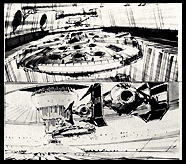"We try to explain how it is done in a storyboard. We will draw right on the board where the matte is going to be or where the split is. All of that information is contained in the little space beneath the board. We use a little form that's very handy because it is broken down into various department needs depending on their involvement in the shot. It is something we have been developing here over the last few years. It's not perfect yet, but we are working on storyboards that will draw themselves. I am really looking forward to that.
"Well, maybe they won't draw themselves, but it is conceivable that in the next couple of years we could have a computer that would do it for us. I would love to sit at the keyboard and type a description and have the thing printed out.
"I'm not a computer an, myself. I don't really like computers, to me it's just another tool I would never play with a computer for fun. That is not my idea of fun. I would rather sketch or do a watercolor. When I said tow years I was exaggerating a little bit. Maybe it will be five years, but it is coming."
Johnston does not think that there will be any less need for artists. "You still need an artist at the keyboard. You will always need a designer. I don't think there will ever be a computer than can design something. I think pre-production art is something that you will always have. I really like to get involved in full-color illustrations, sequences or scenes and that is something a computer will never take over."
There is a reason that Johnston would like a computer to help with the storyboards. "I really like to get in and do the storyboards and get out. I don't like to labor over them On Jedi we have probably done more storyboards than on any other show. We have done probably 2500 storyboards. We end up using maybe 500, but we have done some sequences over and over—three or four times."
Johnston explains, "George Lucas is really the designer, with a capital D. I mean, he is influencing the look of the films by what he picks from our designs. They are really his films, you know. But he knows how to utilize talent. He gives people a lot of freedom. For instance, on this show I've come up with a few designs that were not ever conceived weren't even mentioned in the script, but because he saw and liked them he put them into the film.
He really uses input from others. That is the thing that makes it such a pleasure to work for him, I think. I don't think there are too many directors or producers or filmmakers whatever you want to call him—who have their egos under such control that they can take that kind of suggestion and input from others."
Johnston concludes, "It seems like we are busier on Jedi than we have been before. There are more shots on Jedi and there are more complicated shots. We have tried things that we never would have tried on Empire. We keep thinking everything will get easier because we have more experience after each show. But in order for these films to be successful, you have to keep outdoing yourself by a wide margin. Star Wars was really unique; it had that going for it. Empire had to be technically and aesthetically advanced from that, and Jedi has to outdo Empire. It keeps getting harder every time. I think the public has grown to expect that they are not going to see the same old thing. They want to see something better.
"I think if we were starting from scratch, if Jedi was the first film we tried to do as a group, we would be in big trouble. It is only because we have worked together for so many years and we know how each department functions that we are able to pull this off. It is a giant tapestry of everyone's different talents."
